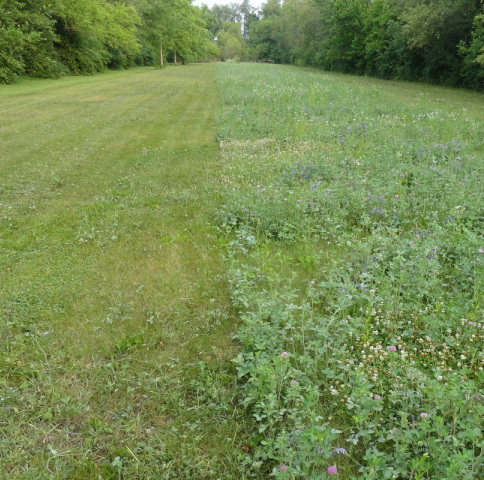By Atticus Murphy
Maybe you’re the type of person who’s interested in nature but don’t know you can help. You live in a city or a suburb, with not much space and just a typical grassy lawn covering what space you have. Maybe you’ve also recently learned that insect pollinators like bees are crucial for our ecosystems but may be experiencing significant declines caused by habitat loss due to humans. What can you do to help, without breaking the bank or spending too much of your time on gardening?

If this sounds like you, there’s a surprisingly simple option available to you: do less! Mowing grass lawns frequently (more than twice a month) is a good way to keep the grass cropped low and cut down on weeds. But this low, flowerless grass lawn is essentially a food desert for bees and other pollinators. Happily, studies have shown that if you simply mow a bit less, your once barren yard can become a buffet for bees in just a few short weeks. Simply shifting towards cutting your lawn every two or three weeks instead of once a week can greatly increase the number of bees and other pollinators that are able to forage there, as quick-blooming “weedy” flowers sprout up from the soil. Instead of treating weeds like unwanted invaders, to help save our native bee populations, treat them like welcomed guests! They’ll beautify your lawn for a few days at a time all throughout the growing season and they’ll do it for free. All it takes it giving them a bit more time between mowing to put up their flowers.
If you enjoy using your lawn for outdoor activities or are required to maintain it at a certain length by local authorities, reducing your mowing frequency as much as you can within these limits is still a great way to help pollinators by giving flowers more of a chance to bloom before cutting them. Remember, this “lazy lawnmower” strategy for helping pollinators does not require drastic lifestyle changes: instead, it might be totally compatible with whatever uses you get out of your lawn now. Green grass can remain on your property for sitting, lying, and playing, and you can see significant numbers of new flowers all while still keeping your lawn looking well-kempt. If you’re concerned about appearances and don’t want to give over the front lawn to being taller, then consider only letting your back lawn grow out a little. Scientists have nicknamed this practice the “landscape mullet” because like the famous haircut, it’s longer at the back. Because pollinators are able to move around to locate flowers, they will be served just as well by a back lawn with flowers as they would a front lawn.

What types of flowers will spontaneously recruit in your lawn? It’s hard to say, and that’s part of the fun! In Massachusetts you might expect to see pollinator-friendly flowers like dandelions (Taraxacum species), clovers (Trifolium species), butter-and-eggs (Linaria vulgaris) and other quick-blooming, low-growing species, like the mustard pictured above. Many of these species may not be native to the U.S., but they are nevertheless great sources of nutrition for native pollinator species. So if you’re interested in helping pollinators but don’t want to make the leap into pollinator-friendly gardening just yet, getting a little lazy with lawn management and welcoming some weeds into your life is a great first step towards making your property a refuge for native insect pollinators.

